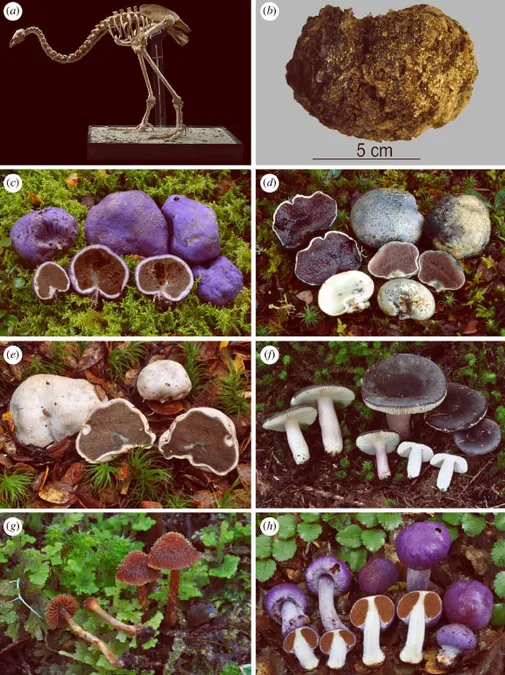
Extinct Moa Feasted on Vibrant Truffle-like Fungi, New Study Reveals!
2025-01-24
Author: Jia
Groundbreaking Discovery
In a groundbreaking discovery, paleontologists have unearthed ancient DNA and spores of truffle-like fungi, including at least one brightly colored species, from the coprolites of the upland moa (Megalapteryx didinus), a massive flightless bird that roamed New Zealand before its extinction.
Co-evolution of Fungi and Moas
These fascinating truffle-like fungi possess fruiting bodies that do not fully open and lack the conventional means of distributing their spores through wind. Instead, they rely on animals to consume them and aid in their spore dispersal, presenting an exciting example of co-evolution.
Globally, many fungi, including true truffles, are characterized by a dull appearance and a strong odor designed to attract mammals. In stark contrast, the truffle-like fungi native to New Zealand boast vibrant colors, closely resembling fallen berries scattered across the forest floor. This intriguing adaptation suggests they were specifically designed to attract fruit-eating birds for spore dispersal.
The Moas’ Role in Ecosystem
While it's hypothesized that these fungi depended on birds for their reproduction, present-day native avian species show little inclination to consume them. Ecologists have long speculated that the primary dispersers of these fungi were the now-extinct moas. However, concrete evidence of this relationship had been elusive until now.
Research Findings
The pivotal study led by Dr. Alexander Boast from Manaaki Whenua-Landcare Research revealed the presence of fungal spores and DNA within two coprolites excavated from Hodges Creek Cave and the Takahē Valley, both located in New Zealand’s South Island. The results confirm that moas didn't just feast on fruits but also indulged in these colorful fungal delicacies.
“Previous research has indicated that moas consumed vividly colored fruits and diverse plant matter, but our latest findings substantiate that they were also eating these striking truffle-like fungi,” the researchers noted. This discovery reinforces the notion that these fungi likely evolved to be particularly appealing to fruit-eating birds.
Moa’s Digestive Impact
Dr. Boast explained that moas, related to ostriches, had the capacity to digest and retain food for extended periods—up to 36 hours. This ability would have enabled them to transport fungal spores over considerable distances, maximizing the fungi's potential for reproduction.
Impact of Moas' Extinction
Yet, with the moa population extinct, the future of these fungi hangs in the balance. The researchers pose critical questions: What will happen to these evolutionary anomalies that rely on species no longer present? How will their disappearance impact the resilience of today’s native forests and their ability to regenerate?
Currently, it is uncertain whether existing herbivorous ground-dwelling birds, like the weka, can fulfill the spore-dispersal role previously occupied by the moa. This potential gap in ecological balance may have cascading effects on the forest ecosystem today.
Symbiotic Relationships
Moreover, vital forest species, such as the extraordinary New Zealand beeches, have formed symbiotic relationships with native fungi. A decrease in these fungal populations—implicated in the moas’ extinction—could adversely impact forest resilience and its overall capacity to thrive.
Conclusion
The findings from this significant study were published in the esteemed journal *Biology Letters* and illuminate the intricate relationships between species in New Zealand's ecosystems. As these ancient mysteries unravel, we are left to ponder the consequences of extinction on the delicate balance of nature.
Stay tuned for more updates as researchers dive deeper into the ecological implications of this fascinating study!


 Brasil (PT)
Brasil (PT)
 Canada (EN)
Canada (EN)
 Chile (ES)
Chile (ES)
 Česko (CS)
Česko (CS)
 대한민국 (KO)
대한민국 (KO)
 España (ES)
España (ES)
 France (FR)
France (FR)
 Hong Kong (EN)
Hong Kong (EN)
 Italia (IT)
Italia (IT)
 日本 (JA)
日本 (JA)
 Magyarország (HU)
Magyarország (HU)
 Norge (NO)
Norge (NO)
 Polska (PL)
Polska (PL)
 Schweiz (DE)
Schweiz (DE)
 Singapore (EN)
Singapore (EN)
 Sverige (SV)
Sverige (SV)
 Suomi (FI)
Suomi (FI)
 Türkiye (TR)
Türkiye (TR)
 الإمارات العربية المتحدة (AR)
الإمارات العربية المتحدة (AR)